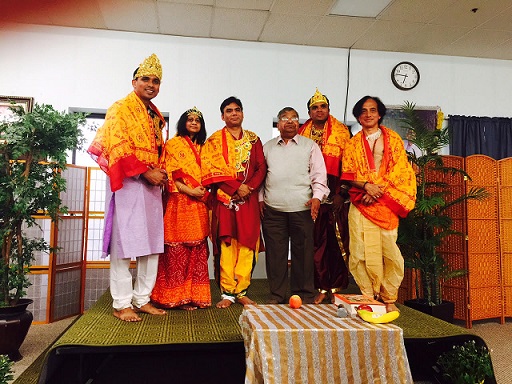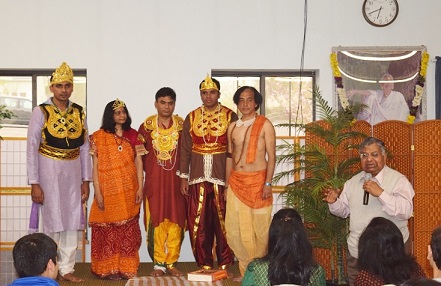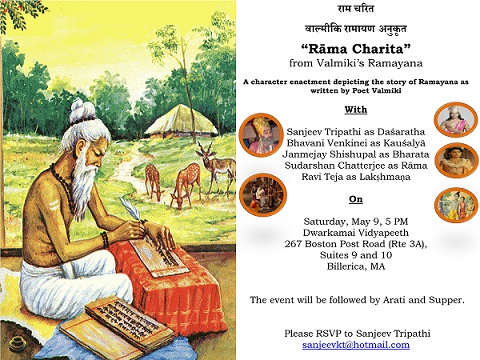Dr. Bijoy Misra initiated a multi-year project of doing a complete reading of the Valmiki Ramayana in the local Sai Temple on May 5, 2013. He reads about two hundred stanzas from the text and explains to an audience that assembles for the reading. The second anniversary of the event was hosted on Saturday, May 9 with the recitation of Ramarakshastotram and a special staging of Ramayana character play. The Ramayana reading schedule is announced in the Calendar of Dwarkamai Vidyapeeth https://www.dwarkamai.com/vidyapeeth/events/events-calendar-view. The reading is expected to be completed in 2019. The link to the first anniversary report is at http://www.lokvani.com/lokvani/article.php?article_id=10172
From the initial discussion Misraji I learned that he was trying to understand the processes that might have gone in to make Ramayana a popular literary piece among the Indian masses. He had read Valmiki’s own admission that he was teaching the voice rendering to his students. Misraji wanted to explore if a dramatic presentation was also possible. Checking with the other scholars back in India he discovered that such an attempt had not been made. Being convinced that Ramayana had great characterizations of personalities, he wanted to explore if there could be passages where the characterization might be presented as spoken by the personalities.
This is challenging because the book Ramayana has been accepted a holy scripture for the Hindus, and the roles should be portrayed without hurting the religious values and sentiments of people. Also, it is not easy for the participants to memorize and deliver the Sanskrit text, by depicting the emotion the great Poet Valmiki had embedded in his writings. This might be the reason why dramatization has only been tried in occasional wedding rituals before. Misraji finally decided to give it a try, and selected five different individual roles of Rama, Lakshmana, Bharata, Dasaratha and Kaushalya to be portrayed by five students.
In the Ayodhya Kanda of Ramayana, King Dasaratha plans on making Rama the king of Ayodhya, but asks him to leave to the forests instead, respecting a boon he had given to his wife Kaikeyi. Rama complies with this decision. Hearing this Rama’s brother Lakshmana becomes very angry. My role was to portray the expressions of an angry Lakshmana to Rama in this scene. Kaushalya is present in the scene through the book, but we enacted each role individually. Kaushalya’s begging Rama to stay back was enacted by another student Bhavani Vankineni through a separate scene. The other roles that were selected were: the reflection of Dasaratha (played by Sanjeev Tripathi) lamenting and tormented in pain scared through the death premonitions, Bharata (played by Janmejay Shishupal) recanting a bad dream on the death of his father to his friends, and Rama (the
best crossbow was played by Dr Sudarshan Chatterjee) persuading Lakshmana and Sita to be patient in reaching the great Sage Agastya’s ashrama. Misraji explained to us that the effort was to present the personality of each character through the character’s own words: Lakshmana the loyal brother, Kaushalya the dependent mother, Dasaratha the Emperor, Bharata the loving son, and Rama the thinker.
After the end of one of the Valmiki sessions on a Sunday, Misraji explained the roles and the Sanskrit stanzas each student would be enacting. The first time I was asked to read my script I stumbled a lot and could not understand a whole lot of words. I practiced reading it twice with Misraji and stumbled again. I realized three important things are important while reading the text. One has to know where to break the Sandhi’s, the second is the diction or the pronunciation of the words, the third is when to give a pause. After practicing and re-reading the script for about a week, I was able to read the script at a decent level. My next step was to know where to break the Sandhi’s, and to understand the meaning of the words. Understanding the meaning of the words is important to show the emotions on face. My conversation with Misraji helped to an extent, but I had to work harder looking for resources. The web site http://www.valmikiramayana.net was helpful to me.
Once I was able to understand and read the Script, I had the daunting task ahead to memorize the script. I tried to memorize it for another week, but I noticed that I was breaking in the middle and was getting stuck sometimes forgetting what the next line was. This was the first time I was doing a play like this on stage, and I couldn’t imagine myself forgetting the script and breaking in the middle of the play. I started reading the script whenever I found time. I tested my memory while I was driving to see on how far I could remember. After about three weeks of practice, I memorized the script and was able to deliver it without looking at it.
My next step was to work with the diction and pause between the words. We scheduled practice sessions at various times suiting to everyone’s convenience. Misraji helped correct my diction along with others. He taught the delivery and the required pause in between in order to present like a speech. I practiced my role with other students, and improvised on it by taking their inputs.
We planned on the costumes to wear, the preparation of the stage, the music that needed to be played on the background. Eminent dance teacher Jasmine Shah loaned us the costumes like the royal dresses, crown, beads, and jewelry. Dr Chatterjee came up with good background music appropriate for each character on the scene.
I was a little nervous initially when I was on the stage, but felt comfortable once I started with the play. I enjoyed playing my role. We had a good audience. A lot of people gave complimentary feedback on the play, and I received good review on my role. The dialogues of Lakshmana, where he goes to an extent of saying that he could kill all people in Ayodhya to make Rama the king, was a “hit†with the audience. Later I posted my video on my Facebook page. People gave excellent feedback.
We (all students of the Sanskrit class) feel grateful to our teacher (Bijoy Misraji) for giving us this unique opportunity in portraying and bringing to life the roles characterized in Valmiki Ramayana. We had some glitches here and there during the play and with the production. But at the end we received good compliments from the assembled audience. Each of the students enjoyed his/her role immensely. We will try to perform different episodes next year in May.
Acknowledgements
• We acknowledge Jasminji Shah for helping us with the costumes for this play.
• We acknowledge Sandeep Srivastava for helping with the setup of the stage.
Video Links of the play
If you are interested in Ramayana events or the reading you can contact Raviteja Varanasi at teja2006@gmail.com or Sanjeev Tripathi at sanjeevkt@hotmail.com. The Sai Temple inquiries can be directed to Sandeep Srivastava at sandeeps@rocketmail.com.
Let Sai bless all.





